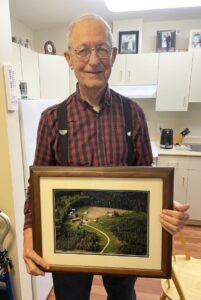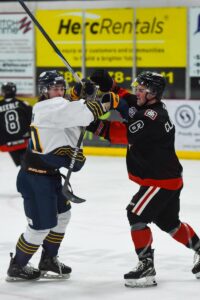
Being a firefighter takes a lot of training, discipline, and being physically fit. With a department of about 45 volunteer firefighters, teamwork and communication play a significant role when it comes to dealing with emergencies, and everyone must be on the same page for the scene to run safely, smoothly, and effectively in a very short time.
To become a firefighter, you must go through the accredited courses and become certified, but you also need to stay sharp and hone your skills which is why crew members practice weekly. Each Tuesday, the firefighters all get together at the station to spend an evening going over equipment, tactics, and technical skills in a classroom setting. The Whitecourt Fire Department does get frequent emergency calls; however, that doesn’t exclude the members from needing weekly training or live training scenarios.
Last Tuesday marked the night in which department members conducted their semi-annual live fire training scenarios. Deputy Fire Chief Aaron Floyd explained, “This night of fire practice is a bit different as we have many evolutions built into it to run tests and do evaluations of the crew members to see where we’re at and if there’s anything more specific we need to focus on, get better at, or make adjustments.” The evening’s practice also served as excellent preparation for 12 of the departments current firefighters as they’ve been preparing for their 1001 Level 2 Evaluations exam through Norquest College’s fire training program which took place over the past weekend. The 12 members will join 11 other local area college students for a full weekend of evaluations to pass and receive their Level 2 accreditation. “Tuesday’s training was just a final checkpoint to make sure they were prepared and on par for their Evaluations exam,” says Floyd.
With 30 firefighters in attendance for the live-fire training, members split into various teams of the initial attack, and the backup and rescue team that follows minutes after. The training props used are two seacans stacked and interior designed to simulate a house with rooms, hallways, and stairs leading to second-floor rooms. Wooden pallets are lit on fire in an unknown location inside the seacans to give it the effect of a house fire that’s also filled with heavy smoke making for minimal visibility. The purpose is to create a little element of heat, stress, and pressure on the firefighters, not to mention the two dummy victims which get placed in the home. Crews must enter the building donned in full fire gear and breathing apparatuses and make their way through every room looking for persons who may be trapped inside and rescue them while simultaneously putting out the fire. All the while, the Deputy Fire Chief is outside timing them and listening to how the crews communicate with each other on the radio while they go through the scenario.
“The crews performed very well; they always impress me. We have a well-trained department which is great to work alongside. In a real fire situation, we roll up on the scene with a minimum two-truck response fully staffed with five members on each engine,” Floyd said. For the public, it may seem like a lot when two trucks pass by, but Floyd explained, “For one fire engine, one member runs the truck, another is the officer which leaves only a three-person crew. The three members have a lot of work to do in the first five minutes as they are the attack crew, leaving the second fire truck staggered back as the backup and rescue crew. The second truck can serve as an additional resource for larger fires or remain on scene in the event the initial fire truck experiences pump issues.”
In the training scenario, crews were able to get water flowing and have the fire under control in about one minute. A minute later, both victims were located and removed from the building. In a real emergency, upon arrival, the benchmark is to have trucks staged, hoses out, and water flowing to the fire whether it’s inside or outside in about two minutes. The public can impede on these times when on the streets or driving by and not giving crews enough space to move in quickly and efficiently.







More Stories
Reminiscing with Residents: Spruceview edition with Jurgen Moll
A great ending to the regular season, with the post-season coming up next
The Wolverines are on fire as the countdown to the playoffs is on